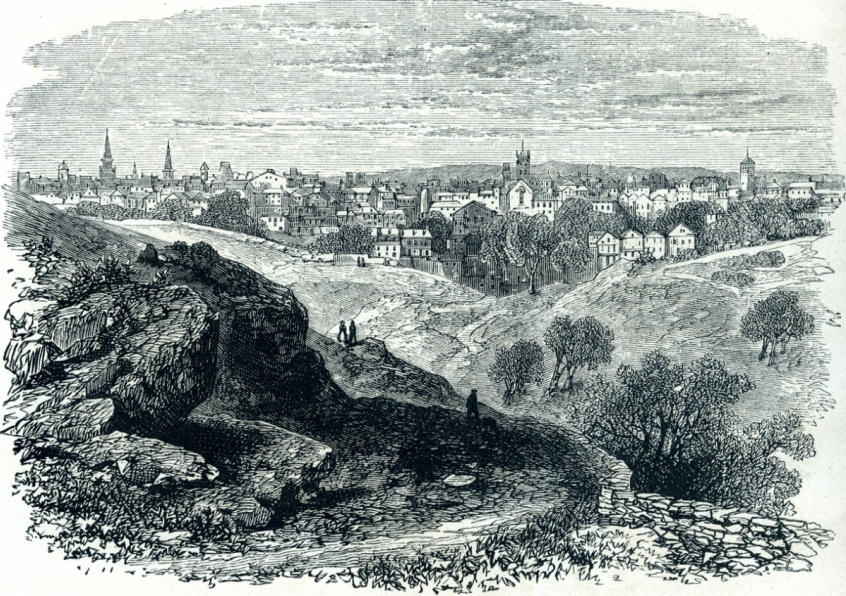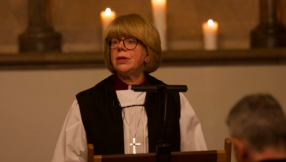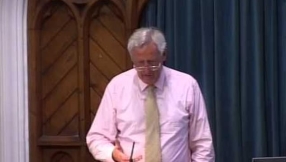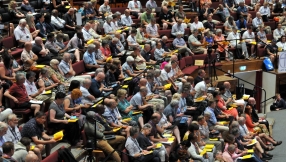
The writer of the Letter to the Hebrews reminds Christians that they are surrounded by a great "cloud of witnesses." (NRSV) That "cloud" has continued to grow in size since then. In this monthly column we will be thinking about some of the people and events, over the past 2000 years, that have helped make up this "cloud." People and events that have helped build the community of the Christian church as it exists today.
Three hundred and thirty years ago this month, a crisis that had engulfed Salem, Massachusetts, was finally drawing to its official close. What had occurred had, arguably, been the most famous witch hunt in history.
Today, the phrase "witch hunt" has entered common usage. One of its meanings (as defined by the Oxford English Dictionary) is: "A campaign of persecution by a group or person in a position of power against a person or group considered to be undesirable by virtue of their views or activities."
The phrase is often used to suggest that those doing the "hunting" are persecuting without just cause, as in: "I am the victim of a witch hunt." A well-known former president of the USA frequently uses the phrase to describe criticisms (and now legal actions) against himself.
However, in its origins, witch hunting is inextricably connected with a particularly troubled period of Christian history.
The roots of the phenomenon
Despite a lot of assumptions to the contrary, witch hunting was not a medieval preoccupation. While there were some medieval examples, its intensity occurred in what historians describe as the "Early Modern Period" and the greatest numbers occurred in the seventeenth century (ironically as a more scientific understanding of the world was slowly emerging).
The New Testament has very little to say about witches and witchcraft, and it was certainly not a preoccupation in the Christian scriptures. Seventeenth-century believers would have been more aware of it from the Old Testament, where they would have found twelve uses of the term. Given this limited Biblical focus on witchcraft it is not surprising that – while magic, spells and sorcery were condemned in medieval law codes – the hunt for witches was not a major preoccupation of the church. Indeed, St Augustine suggested that witchcraft principally consisted of idolatry and illusion used to mislead others. This indicated that the sin lay in the will of the person involved, not in their ability to work magic.
Outlooks began to change in the fifteenth century, when the idea started to grow that witchcraft might be a reality, rather than a heretical illusion. Then, in 1487, a book entitled Malleus Maleficarum (Latin: Hammer of Witches) was published and was soon rapidly disseminated by printing (a fifteenth-century parallel to the impact of the modern internet). Driven by attempts to explain societal problems and conflicts, and deeply misogynistic (women, it alleged, were most likely to be witches), it coincided with the anxieties of many (especially many men) in turbulent times.
As interest in the apparent danger posed by witchcraft grew during the sixteenth century, the distinctive imagined characteristics of witchcraft came to be promulgated: a pact with the devil; meeting in sabbats; the presence of imps in animal form ("familiars") as part of diabolical rituals; and night-flying.
Alongside this developed the alarming notion that the enormity of the crime meant that those accused should not be accorded the normal safeguards of the law and that this also applied to those who defended them. The ingredients of a moral panic, which would spiral out of control, were being mixed in a lethal cocktail.
Coinciding with a lengthy period of conflict and uncertainty – the Reformation division in the church, ensuing wars of religion, attendant economic and social turbulence, outbreaks of infectious diseases, challenges to the social hierarchy – the phenomenon of witch-hunting exploded. Between 1450 and 1750, between 30,000 and 50,000 people were executed in Europe and North America as alleged "witches."
The connection with social anxiety and the breakdown of legal structures is apparent in the fact that 60 per cent of those (most of them women) executed for alleged witchcraft in England died between 1644 and 1646, during the civil war. Most of these English deaths occurred in East Anglia and were due to the activities of "Witchfinder General" Matthew Hopkins, his associate John Stearne, and others swept up in the moral panic that they encouraged. A much larger number were executed in Scotland.
It should be noted that study of the evidence indicates that the vast majority of victims had not engaged in witchcraft and were actually members of the Christian community. Larger panics tended to start with socially (and economically) vulnerable victims (usually women) and then worked their way up the social scale as the hysteria spread; this then could draw in some men as victims.
But most (between 75% and 90% in Britain) of those executed were women and poor, the victims of scapegoating for the ills of their society. Scores were settled and money made by confiscating the property of those convicted. Some, who were probably mentally ill, denounced themselves. Convictions leapt when (as in Scotland and during the East Anglian witch hunts) forms of torture were used to extract "confessions," and when educated elites encouraged or condoned the hunts.
The Salem Witch Trials
The phenomenon of hunting witches spread to the Puritan colonies in New England between 1647 and 1663 and broke out again there, at Salem, in 1692–93. The infamous events at Salem reveal in microcosm much that drove witch-hunting generally, albeit with the causes there being rooted in very local experiences.
In the North American examples, those who drove the hunts forward came from Puritan communities whose outlook mirrored that found in Britain and who used methods pioneered by the East Anglian witch hunters of the 1640s.
Massachusetts in the 1690s was tense. As New England towns became increasingly connected to the outside world, they became less cohesive and their inhabitants less deferential to their Puritan elites; Baptists and Quakers (regarded as heretics by mainline Puritans) were beginning missionary activities in Massachusetts and winning converts; there was economic disruption following a British war with France in the American colonies,1689–92 (King William's War); a smallpox epidemic had hit the area; there was fear of neighbouring Native American tribes. Many Puritans were becoming increasingly anxious and were culturally primed to see all this as the work of the devil and those who served the devil. These anxieties were contagious.
In January 1692, some young girls from Salem Village exhibited fits and uncontrolled screaming. They accused several local women of witchcraft. Other young girls began to show similar symptoms that today would undoubtedly be diagnosed as mass hysteria. Names of "possible suspects" were suggested to the girls. The situation exploded.
Several of those accused of being witches confessed to the court at Salem and named "accomplices." The local court was soon overwhelmed and, in May 1692, the governor of Massachusetts, ordered the establishment of a special court to deal with these witchcraft cases.
In June, the first "witch" was hanged. She was soon followed by eighteen others, with 150 more accused as the phenomenon spiralled out of control. The escalation was accelerated by the courts accepting so-called "spectral evidence" (testimony involving dreams and visions) as being admissible in court. Evidence-based legality was overwhelmed by these (supposedly) spiritual insights. It was a lethal transgression of legal norms, but by no means unique to the courtroom at Salem.
The hysteria was finally ended in October 1692, when the governor intervened and dissolved the special court. It was clear that things were getting out of control. At the same time, some New England Puritan leaders took a stand against the use of "spectral evidence" and insisted on the application of normal legal procedures.
This took courage in the fevered situation, as critics of the witch hunting ran the risk of being themselves accused of witchcraft. One leading minister stated: "It were better that ten suspected witches should escape than that one innocent person be condemned." In May 1693, the governor pardoned and released all those still held in prison on witchcraft charges. The hysteria was over.
In January 1697, the Massachusetts General Court declared a day of fasting for the victims of the Salem witch trials. Later, the trials were declared unlawful, all those condemned were cleared and compensation was paid to their heirs. Never again were any so-called witches executed in New England.
Back to Britain. In Scotland the witch hunts lasted until 1727, when the last Scot was executed; and they were officially stopped across Great Britain in 1736 (the last person executed in England was hanged in 1682). In 1751 an elderly woman at Tring (Hertfordshire) was accused of witchcraft, forced to do a "swimming test" (forcibly thrown into water to see if she floated or sank) and died as a result. One of the men responsible was hanged for murder. Times had changed and the law no longer recognised the existence of magic as a cause of events.
What can modern Christians learn from the witch hunting craze?
At Salem a – once-dominant – group felt increasingly disempowered in the face of social change. The trials there illustrate the dangers inherent in a community that was deeply imbued with a sense of its own righteousness; where high levels of mutual policing combined with hunting out imagined "others," alongside the uncritical acceptance of claimed spiritual insights; while normal standards of legality were suspended. What can we learn from this in the twenty-first century?
We live in a world of conspiracy theories and social-media-generated anxieties, accusations, and moral panics. Many of these defy rational analysis and are impervious to analytical scrutiny. A number insist on the existence of malign forces constituting a "deep state," which is invisible yet global in its corrupting power and influence. At its most extreme, there are even accusations regarding the existence of a cabal of Satan-worshipping paedophiles; using terms that could have come directly from a seventeenth-century witch trial.
Minorities, the marginalised, and perceived "outsiders" are often targeted and vilified. Deep polarisation reduces communication with those in a rival "tribe" and encourages a willingness to believe the worst about them.
In this context, some Christian communities today exhibit a besieged outlook which is quick to frame others as enemies of God. Research reveals that, globally, many evangelicals are drawn towards conspiracy theories. There can be impatience with "worldly" legal norms if these are felt to impede progress of a "godly" agenda, and a willingness to accept collateral damage in some areas of community life to achieve a key goal.
This is sometimes combined with a sense of personal spiritual authority, which can override analytical reflection and chaffs at restrictions on action. That is especially so when allied with powerful interest groups who promise support in imposing the kingdom of God on a seemingly recalcitrant society when persuasion fails.
Salem of 1692–93 is, in many ways, another world. However, in other ways it is not so far distant from the fevered, anxious, angry, and polarised world of today. We need to be on our guard.
Martyn Whittock is an evangelical historian and a Licensed Lay Minister in the Church of England. The author, or co-author, of fifty-five books, his work covers a wide range of historical and theological themes. In addition, as a commentator and columnist, he has written for several print and online news platforms and been interviewed on TV and radio news and discussion programmes exploring the interaction of faith and politics. These have included being interviewed on news platforms concerning the religious dimension to current US politics, Christianity and the Crown in the UK, and the war in Ukraine.
His most recent books include: The Secret History of Soviet Russia's Police State (2020), Daughters of Eve (2021), Jesus the Unauthorized Biography (2021), The End Times, Again? (2021) and The Story of the Cross (2021). His book, Apocalyptic Politics (2022), explores the connection between end-times beliefs and radicalized politics across religions, time, and cultures. He has an interest in the seventeenth-century Puritans and their continuing impact on the modern world. This is explored in his books When God was King: Rebels & Radicals of the Civil War & Mayflower Generation (2018), Mayflower Lives (2019) and Trump and the Puritans (2020).













